👉👉 🇺🇸 All Posts 🇬🇧 / 🇯🇵 記事一覧 🇯🇵 👈👈
♦️Introduction
ASA-PS appears on every preoperative anesthesia note and in most OR information systems. It’s the most widely used “shorthand” to communicate baseline physiologic status before surgery—useful for the whole perioperative team.
♦️What is “ASA”?🤔
“ASA” stands for the American Society of Anesthesiologists. The ASA introduced the Physical Status (PS) Classification to standardize how we describe patients’ pre-anesthesia comorbidities. (Japanese Society of Anesthesiologists = JSA.)
The statement with official definitions and example cases is maintained by the ASA.
🔗 American Society of Anesthesiologists
♦️ How the scale is used
ASA-PS has six classes; “E” is appended for emergency cases.
🔗 Statement on ASA Physical Status Classification System
🔷 ASA-PS1:“Totally healthy, feeling great!” 💪
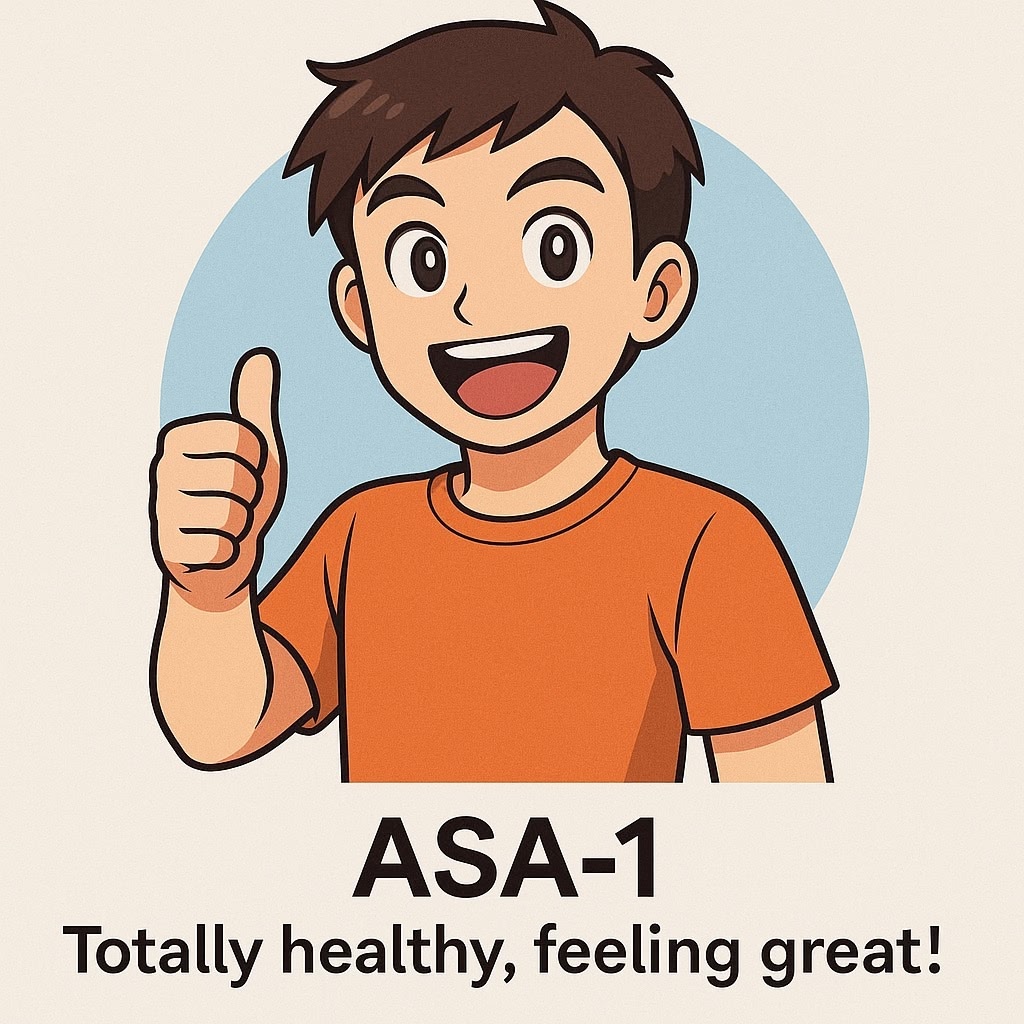
- Basically no medical problems; a normal healthy patient. This is the easiest group for anesthesia management.😊
🔷 ASA-PS 2:Got some medical issues, but basically doing fine! 🙂
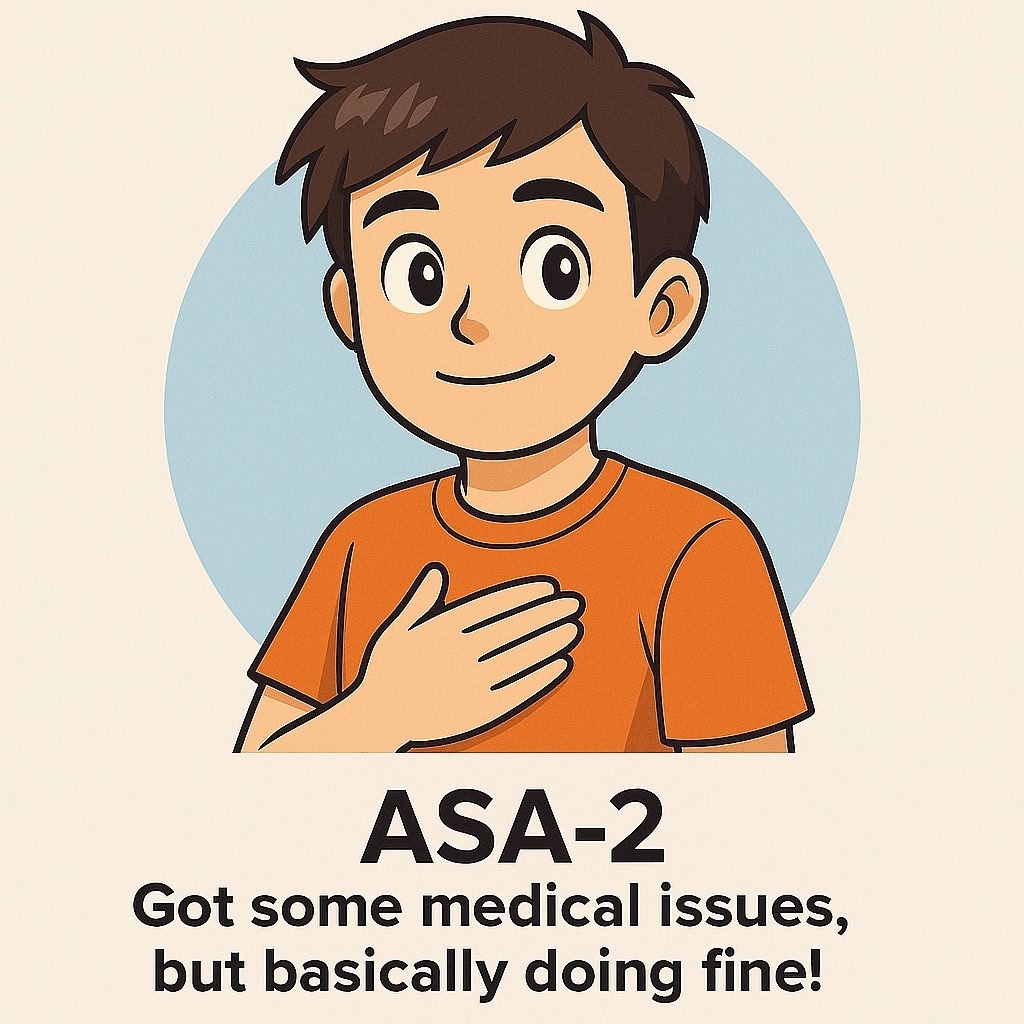
A patient with mild systemic disease, well controlled, and no limitation in daily activities. Basically, these patients don’t require us to be overly concerned from an anesthesia standpoint.
- controlled hypertension or diabetes,
- obesity (not morbid),
- current smokers without respiratory symptoms
- well-compensated chronic conditions
👉 The definition of ASA II is broad. Some propose splitting it into “2a / 2b” for patients who are nearly healthy vs. those needing extra caution (Daabiss, 2011). Although not official, it can help communication. Institutions often provide concrete local examples to improve inter-rater agreement.
🔷 ASA-PS 3:Their health problems are really slowing them down… 😓
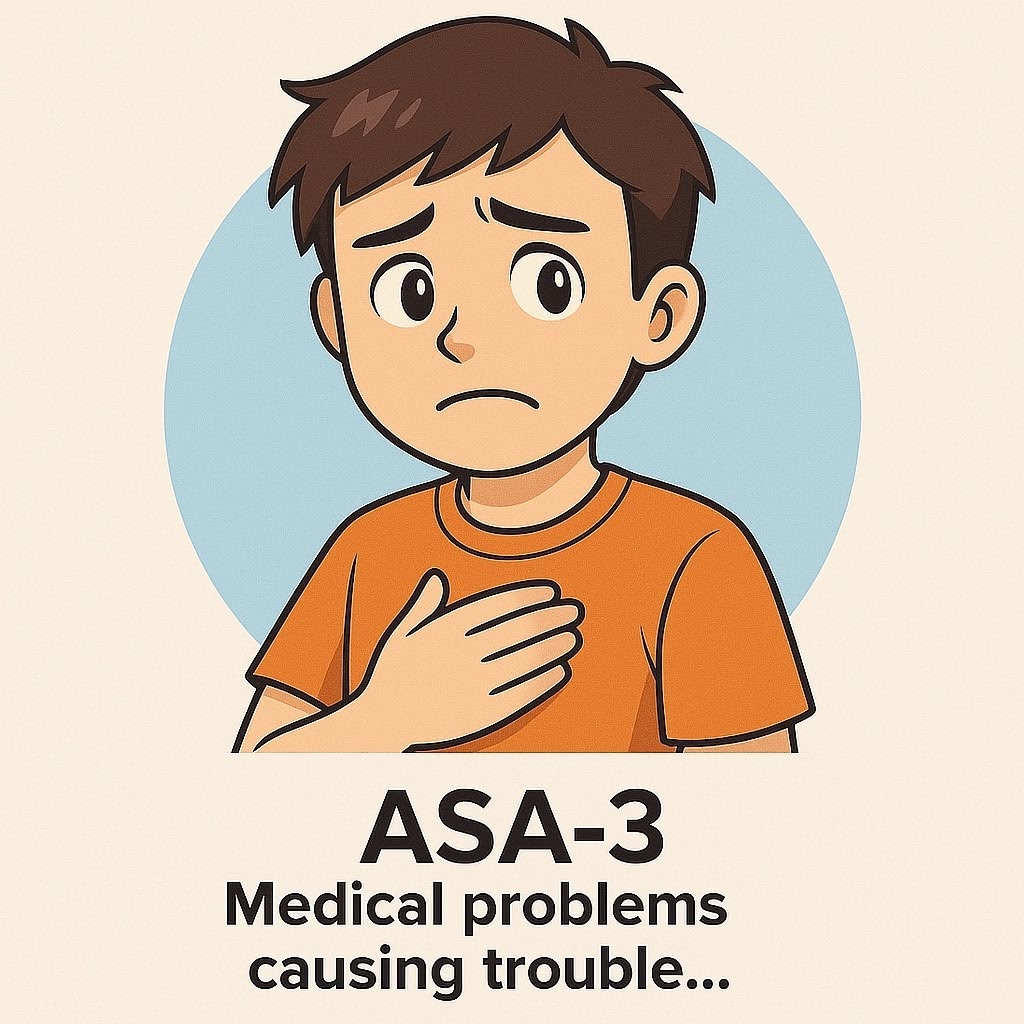
A patient with severe systemic disease that limits daily activity.
- poorly controlled hypertension or diabetes (For diabetes, the presence of complications (nephropathy, retinopathy, neuropathy, etc.) puts the patient into ASA III)
- morbid obesity,
- pacemaker,
- severe hepatic impairment,
- dialysis,
- ischemic heart disease,
- valvular heart disease with dysfunction.
👉 These cases aren’t always obvious on first glance. Anesthesiologists must identify key risk factors and manage carefully to prevent perioperative complications.
🔷 ASA-PS 4:This is life-threatening… things look rough. 🚨
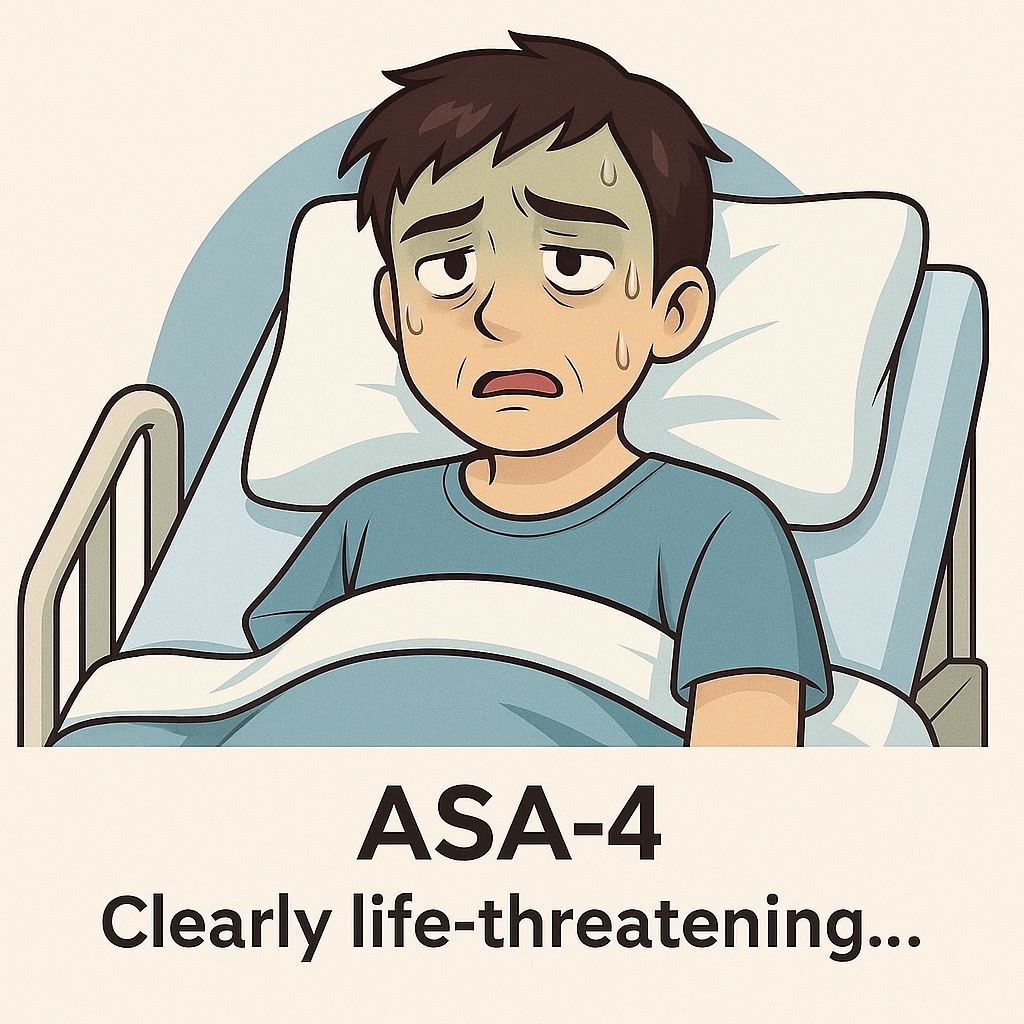
It’s obvious to everyone that the patient is critically ill. A patient with severe systemic disease that is a constant threat to life.
- recent myocardial infarction
- severe valvular disease
- decompensated heart failure
- shock
- sepsis
- Typical scenarios: emergency CABG, strangulated bowel, perforated viscus requiring urgent surgery.
👉 Intraoperative hemodynamic control is usually very challenging.
🔷 ASA-PS 5:Hanging by a thread… surgery is the only chance, but odds are bad. 💔
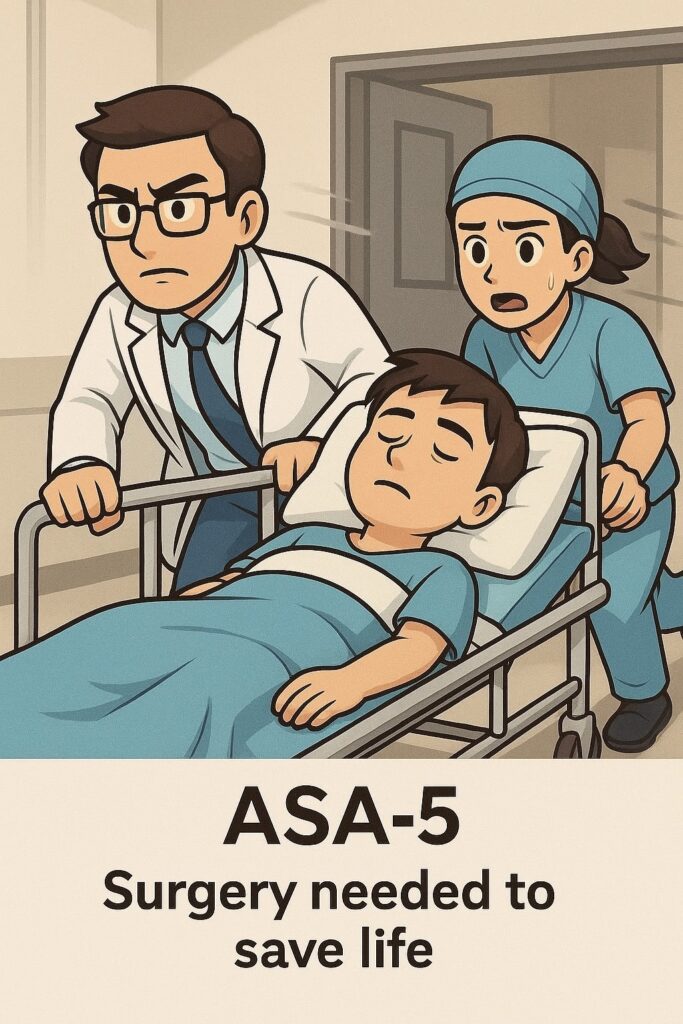
A moribund patient who will not survive without the operation, and may not survive even with it.
- ruptured aortic aneurysm,
- severe polytrauma,
- massive intracranial hemorrhage,
- ECMO-dependent cardiac/respiratory failure,
- ischemic bowel with necrosis,
- advanced liver failure,
- multiple organ failure.
👉 These are extremely difficult cases for anesthesia, surgery, and the perioperative team.
🔷 ASA-PS 6:Brain-dead organ donor 🧠🫀
A declared brain-dead patient whose organs are being removed for donation.
⚠️ Gray zones and inter-rater differences
ASA I vs II, or III vs IV are usually clear. But ASA II vs III is often debated: some anesthesiologists rate an elderly but active patient with comorbidities as II, others as III (considering reduced physiologic reserve).
ASA-PS does not directly affect billing, but it’s a mandatory part of preop assessment and serves as a common language for the surgical team to share risk. The usual practice: if in doubt, lean toward the higher class to ensure safety. 🤗
- ASA II vs III is where many disagreements occur in practice. Surveys and cohort studies show only moderate inter-rater reliability overall; agreement improves when raters use the official ASA examples and local, institution-specific examples. PubMed+2PubMed+2
- Because ASA II spans a wide “mild disease” range, some authors have suggested subdividing lower classes (e.g., I/II into “a” and “b”) to better express nuance. This is not part of the official ASA system, but it has been explored in the literature. PMC
- Use the ASA examples (and your department’s example list) to harmonize ratings between preop clinic and day-of-surgery. Quality-improvement work shows this improves agreement. BioMed Central
- When in doubt—and especially for team communication—clinicians often err toward the higher class and document the rationale.
📝 Summary : Take Home Points
- ASA-PS = common language, not a risk calculator; pair it with procedure and patient-specific risk tools.
- Know the official examples—that’s the fastest way to reduce II vs III disagreements across the perioperative team.
- “E” matters: always add it for emergencies (e.g., 3E).
📚 References & Further reading
- American Society of Anesthesiologists. Statement on ASA Physical Status Classification System (official definitions and examples). Dec 13, 2020. asahq.org+1
- Daabiss M. American Society of Anaesthesiologists physical status classification. Indian J Anaesth. 2011;55(2):111-115. (Open-access review; discusses proposals such as subdividing lower classes.) PMC
- Sankar A, et al. Reliability of the American Society of Anesthesiologists physical status scale in clinical practice. Br J Anaesth. 2014;113(3):424-432. (Moderate inter-rater reliability in practice.) PubMed
- Abouleish AE, et al. Improving agreement of ASA physical status class by adding institutional-specific and ASA-approved examples. Perioperative Medicine. 2020;9:34. (Open access QI project.) BioMed Central
- Cleveland Clinic. ASA Physical Status Classification System (patient-facing explainer reinforcing “not a sole predictor”). Cleveland Clinic

コメントを投稿するにはログインしてください。